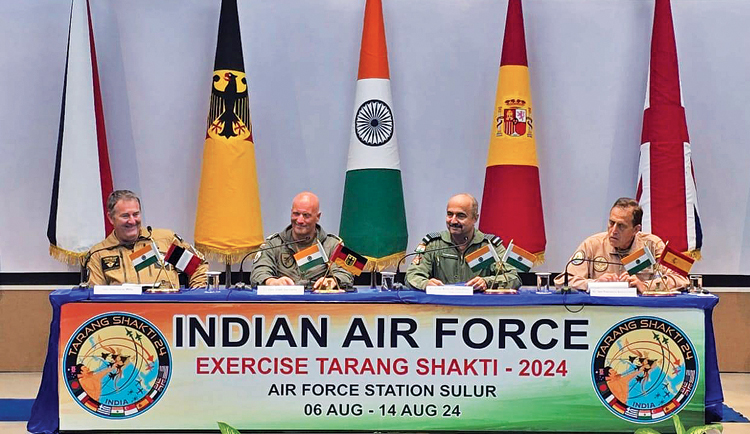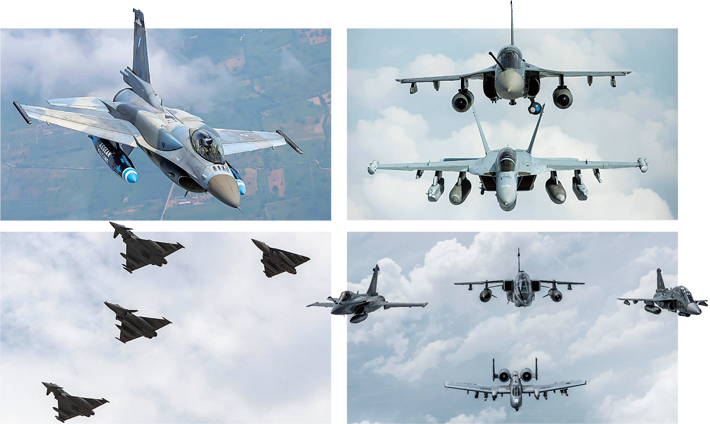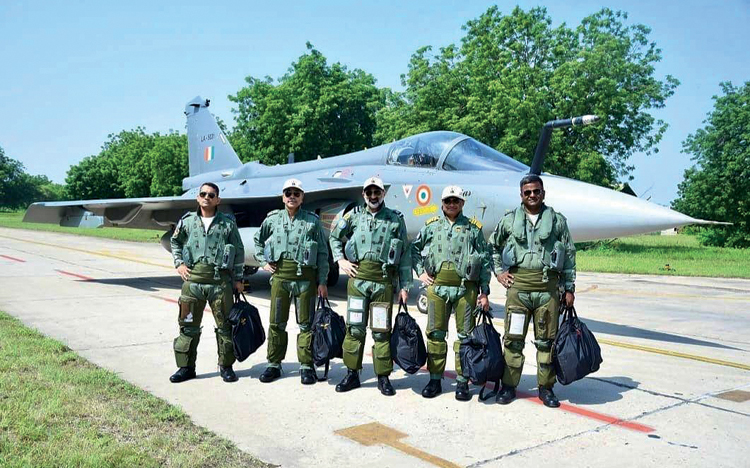INDIAN ARMED FORCES CHIEFS ON OUR RELENTLESS AND FOCUSED PUBLISHING EFFORTS

The insightful articles, inspiring narrations and analytical perspectives presented by the Editorial Team, establish an alluring connect with the reader. My compliments and best wishes to SP Guide Publications.

"Over the past 60 years, the growth of SP Guide Publications has mirrored the rising stature of Indian Navy. Its well-researched and informative magazines on Defence and Aerospace sector have served to shape an educated opinion of our military personnel, policy makers and the public alike. I wish SP's Publication team continued success, fair winds and following seas in all future endeavour!"

Since, its inception in 1964, SP Guide Publications has consistently demonstrated commitment to high-quality journalism in the aerospace and defence sectors, earning a well-deserved reputation as Asia's largest media house in this domain. I wish SP Guide Publications continued success in its pursuit of excellence.
Showcasing Power of Collaboration
Exercise Tarang Shakti, India’s largest multinational air exercise aimed at enhancing interoperability and strengthening operational capabilities, also demonstrated India’s growing stature in global military and defence production

Amongst the various bilateral and multilateral combat exercises that the Indian Air Force (IAF) participates with its Friendly Foreign Countries, the recently concluded Exercise Tarang Shakti was one of the most talked-off in geopolitical circles and also very well covered by the international media.
This indicates India’s recognition as a serious professional player in the global military arena and a force to reckon with. Exercise Tarang Shakti, India’s largest multinational air exercise was aimed at enhancing interoperability, build better cooperation amongst participating forces, gain operational experience and enhance coordination among Friendly Foreign Countries (FFCs). Primarily, it strengthened partner forces’ capability to work cohesively across multiple domains.
Air Forces of ten friendly nations including Australia, Bangladesh, France, Germany, Greece, Spain, United Arab Emirates, United Kingdom, United States, and Singapore flew in with 67 combat aircraft. There were also 38 observers from 18 countries. This landmark air warfare combat exercise was conducted in two phases at two different locations.
THE FIRST PHASE: AF BASE SULUR
The first phase of Exercise Tarang Shakti was conducted at AF Station Sulur, Tamil Nadu from August 6 to 14, 2024. Sulur witnessed diverse array of advanced fighter aircraft from FFCs operating more than 34 aircraft provided by air forces of four nations, viz. French Air and Space Force, Luftwaffe Air Force, Spanish Air Force, and the Royal Air Force of UK. Overall a total of more than 205 sorties were flown. Exercise involved more than 700 personnel.

The French contingent comprised of Rafale fighter jets, A400M transports, A300 MRTT mid air refuellers and 160 personnel. Five German Eurofighters and an A400M transport aircraft took part. The Spanish Air force participated with its Eurofighters.
Several indigenous platforms, the LCA, Light Combat Helicopter (LCH), Light Utility Helicopter (LUH), trainer HTT-40, and the aerobatic helicopter team, Sarang, took to the skies over Sulur in an air display.
THE SECOND PHASE: AF BASE JODHPUR
Participating forces collaborating during this phase included USAF units, as well as units from the Royal Australian Air Force (RAAF), Sri Lanka Air Force (SLAF), Hellenic Air Force, Republic of Singapore Air Force (RSAF) and United Arab Emirates Air Force.
The exercise was mega in true sense. Jodhpur offers a very congenial and safe flying environment. The base witnessed the USAF participating assets viz. the A-10 Thunderbolt-II and the F-16C Fighting Falcon. The RAAF that deployed for the first time to India, flew the F-18 combat aircraft in the exercise. Jodhpur skies also witnessed German, Spanish and UK’s Typhoon aircraft. Crucial combat enabling roles participation came from the Air Refueling Squadron’s KC-135 Stratotanker and the C-130H Hercules. RAAF also included EA-18G Growler the Electronic warfare aircraft. Luftwaffe Air Force also had A400M participating in the exercise. UAE Air Force took part with its AWACS aircraft. SLAF participated with its C-130 aircraft. A total of 800 sorties were flown during this phase. Besides these active participants, representatives of 18 countries also participated through their observers.
The night skies above Jodhpur reverberated with the thunderous sound of powerful 100 aircraft taking to the skies by night. The night time sorties showcased the skills of the participating forces, demonstrating their remarkable interoperability, thereby demonstrating their readiness of the forces to operate effectively in any appointment by day and night.
IAF PARTICIPATION
In each of these phases, the IAF pitted about 40 plus aircraft comprising of Su-30 MKI, Rafale, Mirage 2000, LCA Tejas Mk1, Jaguar and MiG-29 fighter aircraft. Other aircraft included LCH Prachand, ALH Mk-IV Rudra, C-130, IL-78 FRA, AEW&C. Besides the crew of these platforms, the exercises also provided an unique opportunity to the weapons system operators (WSOs), fighter controllers air traffic controllers. In the Sulur phase, the MiG-29K aircraft of the Indian Navy also participated.
INTEGRATED OPERATIONAL FLYING
Both the phases covered broad array of operational combat scenarios. Flying exercises comprised of unique and challenging scenarios incorporating large force engagements (LFEs), simulating beyond visual range missile engagements of varying lethal envelopes, offensive counter air and air defence exercises were practiced. The scenarios also involved controlling the fighter aircraft by AWACS and AEW&C platform and respective fighter controllers guiding them for a kill. It also offered operational practice to elements of surface to air missiles.

On the sidelines of exercise Tarang Shakti, a series of FFC operational engagements were also undertaken. During the exercise, the 25th Expeditionary Fighter Squadron Commander and Detachment Commander of USAF in India, took to the skies in Su-30 MKI aircraft with the Commanding Officer of the Su-30 MKI squadron of the IAF. He appreciated that, “this training we do here is very rewarding and the partnership we’re building with other squadrons from multiple nations is very valuable.” Another interesting joint event was IAF Su-30 MKI being refueled in the air by Western A330 MRTT MMU tanker aircraft of the Luftwaffe Air Force.
AIR DOMAIN AWARENESS SYMPOSIUM
The multinational level exercise was not just restricted to operational flying aspects, interaction included an academic exchange and a professional development multinational symposium on ‘Air Domain Awareness’ by the IAF on September 11, 2024 at Jodhpur. The theme was ‘Collaborative approach to facilitate air domain awareness towards enhancing regional security.’
This unique symposium had 50 delegates, representing 27 nations, wherein international delegates shared their concepts of air domain awareness and discussed strategies to tackle challenges from both national and regional perspectives. The symposium fostered an open exchange of ideas among subject matter experts on emerging challenges related to air situational awareness and airspace management. Discussions focused on policy matters and technological solutions for effective information sharing.
SHOWCASING INDIAN DEFENCE PRODUCTION CAPABILITIES
With an objective to showcase India’s booming indigenous defence production ecosystem, Defence Minister inaugurated India Defence Aviation Exposition (IDAX-24) from September 12 to 14, 2024. 50 plus participants from DRDO and its labs, Indian DPSUs, private firms and start-ups participated. It provided good exposure to all the participants and local populace. IDAX-24 showcased indigenous skills and indomitable spirit of Indian aviation industries to a wide spectrum of decision makers and end users from global Air Forces. IAF also fielded its LCA Tejas, LCH Prachand and ALH Mk-IV Rudra, the platforms that are competing globally to equip various modern air forces.
FLYING AND GROUND DISPLAYS
The Exercise Tarang Shakti also showcased on the sidelines a display by Agniveer Vayu Women Air Warrior Drill team (AWDT) and demonstration from LCA Tejas, LCH Prachand, Sarang Helicopter Display Team of the IAF flying the HAL manufactured Advanced Light Helicopter (Dhruv) and the Surya Kiran Aerobatic Team (SKAT) IAF, flying the Hawk aircraft. The displays were well appreciated by visiting participants and local populace.
LCA TEJAS PROVES ITS METTLE
Employment of LCA Tejas in almost all exercises, the LCA Tejas became a mascot for showcasing India’s manufacturing prowess. It was seen in action alongside Typhoon, Rafale, F-18, the F-16, fighter aircraft of foreign air forces. Two of the most eyeball catching event were a display of multinational synergy during Phase-1 at Sulur by undertaking a joint fighter aircraft mission by the four Air Chiefs of participating air forces, these included German and French Chief flying the indigenous LCA Tejas Mk1 trainer aircraft while the IAF Chief and Spanish Chief flew sorties in Su-30 MKI.

Another event was the Vice Chiefs of Indian Army, Navy and Air Force creating history by flying together in the indigenously manufactured LCA Tejas. Joint participation in the exercise demonstrated the growing focus on cross domain cooperation with the land, sea and air force working to face operational challenges together.
KEY TAKEAWAYS
Air forces play a critical role in the defence strategies of all nations, enabling them to maintain sovereignty and exert global influence. There is a fair amount of learning by each participant, starting from long distance deployments, coordinating for a mammoth event such as this and scheduling the individual air exercises.
IAF regularly participates with foreign air forces. However, over the past few years there has been a significant increased participation by the IAF in various bilateral and multilateral exercises. It is interesting to note that in last 20 years the IAF has participated in more than 90 air exercises with 32 of them being hosted by the IAF itself. Holding an air exercise in a professional manner conveys a message about the organising capability and enhances the professional stature of any air force.
Overall, Exercise Tarang Shakti provided to the IAF an excellent opportunity to operate alongside some of the best Air Forces of the world. This will help participating nations build strong aviation associations, facilitates interoperability among participants with diverse resources. Also, collation of debrief points and analyses of various issues that emerge leads to lessons learnt and refinement in tactics and employment philosophy that ultimately proves beneficial in enhancing operational capability of the IAF. There is also learning in how to operate an aircraft with or without a datalink, how to create a common communication protocol. Exercises such as these also provide an excellent exposure to the young crew to learn aviation aspects while participating in international environment.
Exercise Tarang Shakti provided a memorable learning experience to all the participating forces. In the words of IAF then Vice Chief of the Air Staff (VCAS), Air Marshal A.P. Singh, “Tarang Shakti was an opportunity to combine cultures and perspectives while building security and interoperability with our participating and observing partners. The spirit of collaboration and embracing diversity is key to not only better executing flying maneuvers, but also to broaden people’s minds.” Defence Minister Rajnath Singh termed the multinational Exercise Tarang Shakti as an effort to strengthen cooperation, coordination and mutual trust with partner countries. Stating that the Exercise Tarang Shakti underscores the growing stature of Indian Armed forces, he added that the ‘resolve of making India Atmanirbhar in Defence is demonstrated by Exercise Tarang Shakti.” He said that the country has transformed from being only an importer of arms and equipment to a nation which today exports arms and equipment to about 90 countries.
Then Air Chief Marshal V.R. Chaudhari announced that IAF will consider exercise Tarang Shakti to be planned as a biennial feature.





